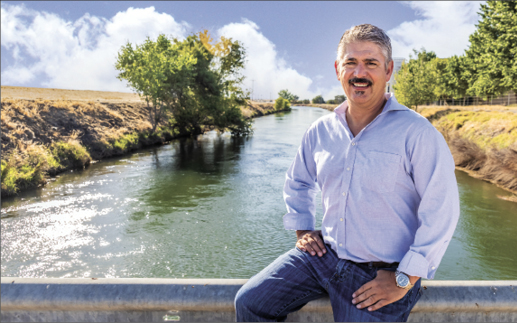One day in early October, a group of University of California, Merced, students went to the campus Smart Farm, augurs in hand, to explore the soil for the best spots to locate moisture sensors.
They were not looking in the root zone to monitor how much water is available but instead for areas lower in the soil to study how irrigation and stormwater can travel far enough beneath the plants to recharge the groundwater below.
“The trick is trying to get more water down to the aquifer and verifying that we did it,” said Tom Harmon, UC Merced chair of the civil and environmental engineering department. “We need to figure out how to measure soil moisture deeper. We usually measure to the root zone, but we have to take it past the plant.”
The ability to monitor how much water is recharging the underground aquifer will become more important as growers have to comply with the Sustainable Groundwater Management Act. It requires that local agencies adopt rules to limit pumping to no more than the groundwater can sustain over time.
“How can you comply with things when you can’t measure them?” Harmon asked. “If we can measure it, maybe we can incentivize it.”
Harmon is part of a coalition of researchers from five universities, led by UC Merced, that will spend the next four years researching and sharing information to help farmers and water agencies make smarter decisions as they live with longer and more severe droughts likely to come.
The U.S. Department of Agriculture awarded $10 million to the four-year initiative Securing a Climate Resilient Water Future for Agriculture and Ecosystems through Innovations in Measurement, Management and Markets, or SWIM.
Farmers already use weather data to manage irrigation and trade water rights with each other. A few use their fields to refill the underground aquifer when water is available, but they should be able to do these things more effectively if they have better information.
“It is important that we improve the information flow from the farm to the district to the region,” said UC Merced watershed scientist Joshua Viers, project director of this effort to develop data-driven practices to make agriculture and ecosystems more water resilient in the face of climate change.
The $10 million is the largest research grant ever awarded to UC Merced and represents something of an emergence as a major research institution for the 16-year-old campus. “It is clear that they believe UC Merced and our affiliates are the right team with the right ideas to help secure a climate resilient water future,” Viers said.
The Merced grant is one of 15 totaling nearly $150 million announced in early October by USDA. UC Davis also received $10 million to study how to sustain irrigated agriculture in the Southwest.
Most farmers already use weather data to schedule irrigation, but the Merced-based researchers hope to help them do this better with an app that will include robust climate information.
“We will be using information from the National Ocean and Atmospheric Administration,” said Viers. “The app is fundamental to what we’ll be doing.”
As water becomes even scarcer and more valuable, better information could make it practical to reward farmers who adopt measures that save water.
“If a grower can be efficient with their water, why shouldn’t they be able to bank it?” Viers asked.
Some researchers are already studying—and a few farmers are already implementing—practices that replenish underground aquifers. Their efforts could benefit from better information.
A UC Davis researcher, Helen Dahlke, is studying water recharge through farm field. Don Cameron, general manager of Terranova Ranch near Fresno, has undertaken his own research effort.
Cameron decided during the storms of 2011 to divert 7,000 acre-feet of water onto 1,000 acres of vineyards, alfalfa and pistachios to learn if they could flood the ground to recharge the aquifer without damaging the crops.
As a youth, Cameron had seen wild grapes growing vigorously with roots submerged in creek water outside Redding and he said he thought the Terranova vines could also survive standing in water.
The gamble paid off and now Terranova is cooperating with the state Department of Water Resources, USDA Natural Resources Conservation Service and the Kings River Conservation District on building infrastructure that will eventually let the ranch recharge up to 1,000 acre- feet a day during storms.
“We have sensors on wells and we got a 40-foot increase in the well level after we did recharge in the 2017 floods,” Cameron said.
The recharge was so slow, however, they had to wait months to see how much of the water they applied made it all the way down to recharge the aquifer below.
“The rise happened three or four months after we flooded the field,” Cameron recalled. “It would be interesting to see when the wave came through.”
– Bob Johnson, California Farm Bureau Federation















